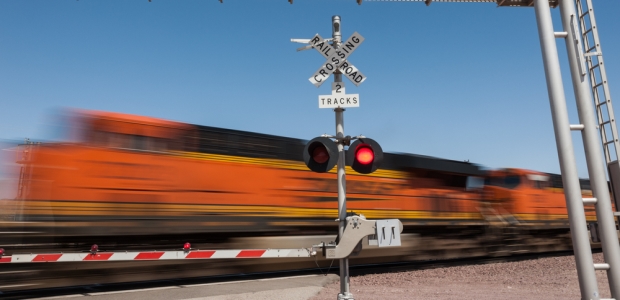
Autonomous Railroads? FRA Seeks Input
Among the questions the agency asks are what are the safety and security issues raised by automation in railroad operations at public and private at-grade highway-rail crossings, and to what extent should DOT coordinate with state or local governmental entities on certain safety or security issues.
A Federal Railroad Administration request for information seeks input from stakeholders, state and local governments, and the public about the future of automation in the railroad industry.
FRA's notice says the agency wants to understand the current stage and development of automated railroad operations and how FRA can best position itself to support the use of new automation technologies to increase the safety, reliability, and capacity of America's railroad system. "As in other transportation modes, there are varying levels of automation that already are, or could potentially be, implemented in the railroad industry. Currently, U.S. passenger and freight railroads do not have a fully autonomous rail operation in revenue service, however, railroads commonly use automated systems for dispatching, meet and pass trip planning, locomotive fuel trip time optimization, and signaling and train control," it says before explaining that, "Internationally, the only known fully-autonomous freight railroad system is in Australia. The system is part of the Australia Rio Tinto mining company and began fully-autonomous train operations on an approximately 62-mile stretch of track in Western Australia. This Rio Tinto train is equipped with a variety of sensors (e.g., radar, cameras, kangaroo collisions sensors) and with a switch to toggle between autonomous operation or operation with an operator on board."
Comments and information responsive to the request are due by May 7, 2018. They should be identified by docket number FRA-2018-0027 and submitted by fax, mail or electronically via www.regulations.gov.
The notice says the Association of American Railroads created a Technical Advisory Group on autonomous train operations in fall 2017. The focus of the group is to define industry standards for an interoperable system to support autonomous train operations.
FRA requested comment and data in response to the several questions, including these:
- To what extent do railroads plan to automate operations? Do railroads plan to implement fully autonomous rail vehicles (i.e., vehicles capable of sensing their environments and operating without human input)? If so, for what types of operations?
- How do commenters envision the path to wide-scale development and implementation of autonomous rail operations (or operations increasingly reliant on automated train systems or technologies)? What is the potential timeframe for technology prototype availability for testing and for deployment of such technologies?
- How does the railroad industry currently define "autonomous operations"? Would it be helpful to develop automated rail taxonomy; a system of standards to clarify and define different levels of automation in trains, as currently exists for on-road vehicles and rail transit? What, if any, efforts are already under way to develop such rail automation taxonomy? Should FRA embrace any existing and defined levels of automation in the railroad industry or other transportation modes such as highways or public transit?
- What limitations and/or risks (e.g., practical, economic, safety, or other) are already known or anticipated in implementing these types of technologies? How should the railroad industry anticipate addressing these limitations and/or risks, and what efforts are currently underway to address them? Are any mitigating efforts expected in the future and what is the timeline for such efforts?
- What benefits and efficiencies (e.g., practical, economic, safety, or other) do commenters anticipate that railroads will be able to achieve by implementing these technologies?
- What societal benefits if any, could be expected to result from the adoption of these technologies (e.g., environmental, or noise reduction)? What societal disadvantages could occur?
- What, if anything, is needed from other railroad industry participants (e.g., rail equipment and infrastructure suppliers, manufacturers, maintainers) to support railroads' automation efforts?
- How does the state of automation of U.S. railroad operations compare to that of railroads in other countries? What can be learned from automation employed or under development in other countries? What are the unique characteristics of U.S. railroad operations and/or infrastructure as compared to railroads in other countries that may affect the wide-scale automation of railroad operations in this country?
- How do commenters believe these technologies could increase rail safety?
- What processes do railroads have in place to identify potential safety and/or security risks, including cybersecurity risks, arising during the adoption of these technologies and that may result from the adoption of such technologies?
- How should railroads plan to ensure identified safety and/or security risks are adequately addressed during the development and implementation of these new technologies? What is an acceptable level of risk in this context?
- How should railroads plan to ensure the integration of these technologies will not adversely affect, and will instead improve, the safety and/or security of railroad operations?
- What are the safety and security issues raised by automation in railroad operations at public and private at-grade highway-rail crossings? To what extent should DOT coordinate with state or local governmental entities on certain safety or security issues? How might automation improve the safety of the general public at highway-rail grade crossings or along the railroad rights-of way?
- How do railroads plan to ensure safety and security from cyber risks?
- What is the potential impact of the adoption of these technologies on the existing railroad industry workforce?
- Would the continued implementation of these technologies, including fully autonomous rail vehicles, create new jobs and/or eliminate the need for existing jobs in the railroad industry?
- What railroad employee training needs would likely result from the adoption of these technologies? For example, if the technology fails en route, will an onboard employee be trained to take over operation of the vehicle manually or be required to repair the technology en route?